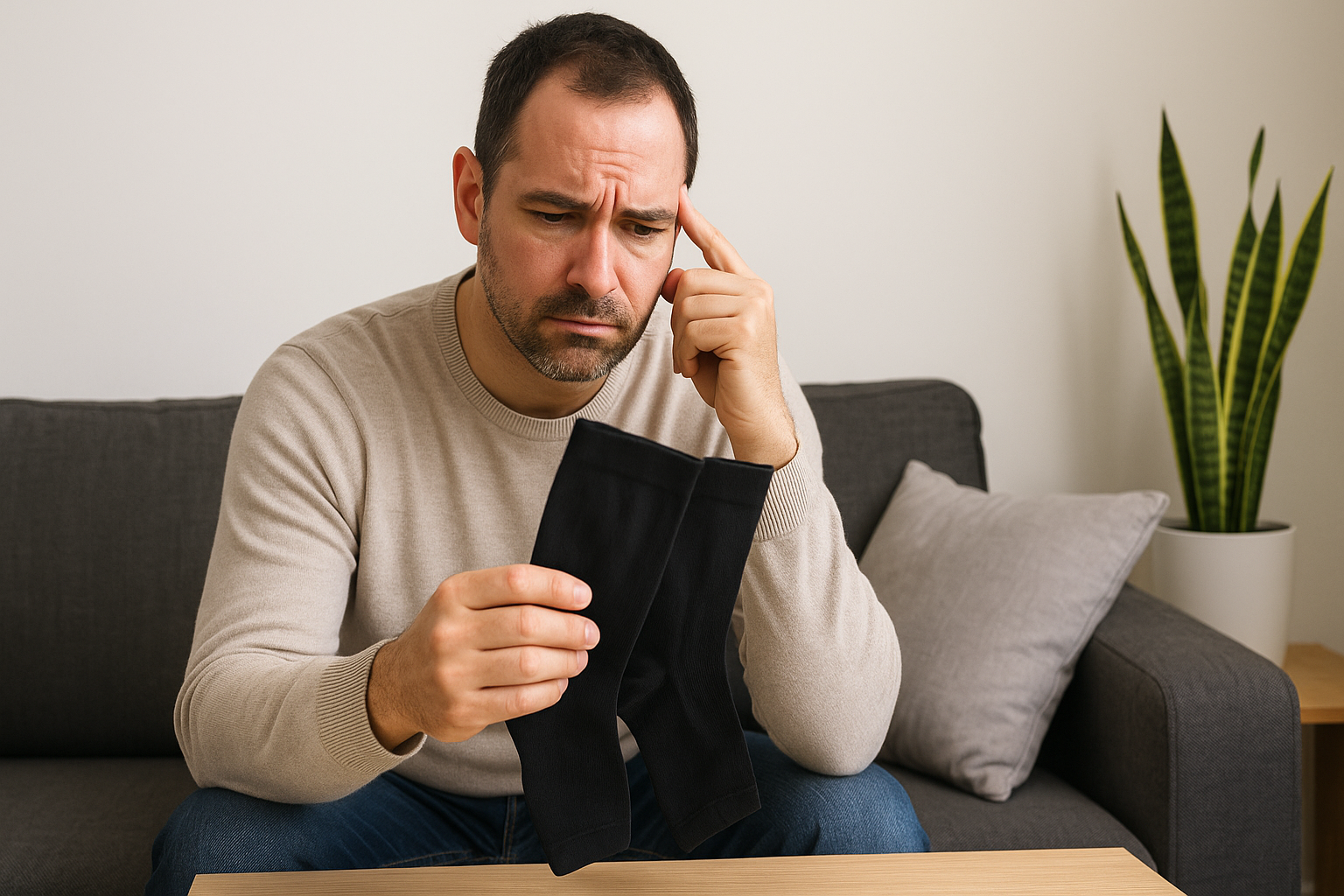Orthopedic socks are often praised for their ability to improve blood circulation, reduce swelling, and relieve pain in the legs and feet. They’re used by athletes, people with diabetes, and anyone who spends long hours standing. However, despite their many benefits, these socks are not suitable for everyone. In certain cases, wearing orthopedic or compression socks can actually cause discomfort or even health complications. So, who should avoid wearing orthopedic socks, and why? In this article, we’ll explore the specific situations, medical conditions, and risk factors that make orthopedic socks inappropriate for some individuals.
Who Should Avoid Wearing Orthopedic Socks?
Orthopedic socks are known for their therapeutic benefits they improve blood circulation, reduce leg fatigue, and provide support for muscles and joints. They’re especially recommended for individuals who spend long hours standing, suffer from varicose veins, or experience swelling in their feet.
However, while orthopedic socks can be extremely helpful, they are not suitable for everyone. Certain people may experience discomfort, irritation, or even complications if they use them incorrectly or without medical guidance. Understanding who should avoid wearing orthopedic socks is essential to prevent potential risks and ensure safe, effective use.
People with severe peripheral arterial disease (PAD)
The most important group that should avoid orthopedic socks are those suffering from severe peripheral arterial disease. PAD causes a narrowing of the arteries, reducing blood flow to the legs and feet. Since orthopedic or compression socks apply pressure to improve circulation in the veins, they can actually restrict arterial flow even further in people with PAD.
This restriction can worsen symptoms such as pain, numbness, or cold feet, and in severe cases, may lead to tissue damage. Therefore, anyone diagnosed with advanced PAD or critical limb ischemia should consult a vascular specialist before using orthopedic or compression socks.
People with advanced diabetes and neuropathy
People with advanced diabetes are another category that should be cautious. Many diabetic patients develop neuropathy, a condition that causes nerve damage in the feet, reducing the ability to feel pain or pressure.
Wearing orthopedic socks that are too tight can cause unnoticed injuries, blisters, or pressure sores, as the user might not feel discomfort until the damage is done. Moreover, restricted blood flow can make healing slower, increasing the risk of infection.
For diabetic individuals, specially designed diabetic socks are a safer alternative. These are non-compressive, have seamless interiors, and help regulate moisture while promoting airflow reducing friction and irritation.
People with skin infections or open wounds
Anyone who has skin infections, ulcers, or open wounds on their feet or legs should avoid wearing orthopedic socks. The tightness of the fabric can trap moisture and bacteria, creating a warm environment where infections thrive.
In addition, compression can aggravate wounds by slowing healing or irritating the affected area. Until the skin has completely healed, it’s best to use breathable, non-restrictive materials and follow a doctor’s wound care instructions before resuming the use of orthopedic socks.
People with severe heart failure or pulmonary edema
Those who suffer from severe heart failure or pulmonary edema should avoid orthopedic socks unless advised otherwise by a healthcare professional. In these cases, fluid retention occurs not only in the legs but also in the lungs and other organs.
Applying external pressure to the legs can cause a redistribution of fluids, which might overload the heart or worsen respiratory symptoms. Therefore, any patient with heart-related swelling should seek medical approval before wearing compression or orthopedic socks.
People allergic to synthetic fibers or elastic materials
Orthopedic socks are often made from synthetic fibers, such as nylon, spandex, or polyester, to ensure elasticity and durability. However, individuals with sensitive skin or fabric allergies might experience itching, redness, or rashes after wearing them for extended periods.
If irritation occurs, it’s best to switch to hypoallergenic orthopedic socks made from natural fibers like bamboo, cotton, or merino wool. These materials are gentler on the skin while still providing light compression and moisture control.
People with improperly fitted socks
Even for those without medical conditions, wearing orthopedic socks that don’t fit properly can cause issues. Socks that are too tight may cut off circulation, leading to numbness and tingling. Conversely, socks that are too loose won’t provide the expected support or therapeutic benefits.
To avoid these problems, always measure your legs before purchasing orthopedic socks and choose the right size according to manufacturer guidelines. Proper fit ensures that pressure is evenly distributed supportive but never restrictive.
People with fragile or thin skin
Older adults and individuals with thin or fragile skin should also use orthopedic socks carefully. The friction caused by tight fabric may lead to skin tears or bruising, particularly around the ankles or calves. In such cases, lightweight, lower-compression socks (between 8–15 mmHg) are preferable, or it may be best to avoid them entirely.
People recovering from leg or foot surgery
After certain surgeries such as vein procedures, knee replacements, or fractures orthopedic socks may not always be suitable. If swelling is caused by post-operative inflammation or bandaging, applying extra compression could interfere with the healing process. It’s crucial to follow post-surgery medical advice, as doctors might recommend compression only at specific times or with custom-made garments.
What Are the Risk Factors That Make Orthopedic Socks Unsuitable for Certain People?
Orthopedic socks sometimes called compression or therapeutic socks are designed to improve circulation, reduce swelling, and alleviate leg fatigue. They are widely used by people who spend long hours standing, athletes, and individuals managing venous insufficiency or diabetes.
However, while these socks can offer significant benefits, they are not suitable for everyone. Certain health conditions and personal factors can turn this helpful product into a potential risk. Understanding these risk factors is essential to ensure safe use and to avoid complications that could harm your comfort, circulation, or overall health.
1. Peripheral Arterial Disease (PAD) and Poor Arterial Circulation
The most important risk factor to consider is peripheral arterial disease (PAD) a condition that narrows the arteries and reduces blood flow to the legs and feet. Because orthopedic socks apply graduated pressure to improve venous return, they can inadvertently worsen arterial flow in people with PAD.
Instead of helping, the compression may restrict oxygen delivery to tissues, leading to pain, numbness, or even tissue necrosis in severe cases. Anyone diagnosed with PAD or showing symptoms like cold feet, persistent leg pain, or pale skin should consult a vascular specialist before wearing orthopedic socks.
2. Advanced Diabetes and Neuropathy
People living with advanced diabetes often experience peripheral neuropathy, a type of nerve damage that affects sensation in the feet. When someone can’t properly feel pressure, temperature, or pain, even a small irritation can go unnoticed.
Orthopedic socks that are too tight can cause pressure sores, blisters, or skin breakdown all of which may lead to infection or ulcers in diabetic individuals. Because healing tends to be slower in people with diabetes, these small injuries can become serious complications.
For these individuals, diabetic socks are a safer alternative. Unlike standard orthopedic models, they are non-compressive, seamless, and made from breathable materials that reduce friction and wick away moisture.
3. Skin Conditions, Open Wounds, and Infections
Another important risk factor is the presence of open wounds, ulcers, eczema, or fungal infections on the feet or legs. Compression can trap heat and moisture, creating an ideal environment for bacterial growth. Additionally, the friction from the sock’s fabric may irritate damaged skin or delay healing.
If you have any visible sores, redness, or inflammation, it’s best to pause the use of orthopedic socks until the area is completely healed. Always consult a healthcare professional for proper wound care before resuming use.
4. Congestive Heart Failure or Pulmonary Edema
Individuals with severe heart conditions, such as congestive heart failure or pulmonary edema, must be cautious. These conditions often involve fluid retention in the legs, lungs, and other parts of the body.
Using orthopedic socks can push this retained fluid back toward the heart, potentially overloading the cardiovascular system and exacerbating breathing problems. For anyone with a known cardiac condition, medical clearance is essential before starting compression therapy.
5. Allergic Reactions to Materials or Dyes
Orthopedic socks are typically made from elastic blends containing nylon, spandex, or polyester, sometimes combined with rubberized fibers for elasticity. For people with sensitive skin or allergies, these materials can cause itching, redness, or contact dermatitis.
To minimize this risk, it’s best to choose hypoallergenic orthopedic socks made from natural fibers such as cotton, bamboo, or merino wool, which provide gentle compression without causing irritation. Avoid socks with synthetic dyes or strong chemical finishes.
6. Incorrect Sizing or Excessive Compression
A surprisingly common risk factor is wearing the wrong size. Orthopedic socks that are too tight can cause restricted circulation, numbness, and tingling sensations, while socks that are too loose fail to deliver the desired therapeutic pressure.
Moreover, compression that’s too strong (for example, above 30 mmHg without medical supervision) may create uneven pressure and harm the veins or skin. Proper sizing based on ankle, calf, and leg measurements is crucial. Always follow manufacturer guidelines or seek professional fitting advice to ensure even, comfortable pressure distribution.
7. Thin, Fragile, or Aging Skin
As we age, our skin naturally becomes thinner and more fragile. Older adults or individuals on corticosteroid treatments often have delicate skin that’s prone to tearing or bruising.
When orthopedic socks apply even gentle compression, they may cause skin irritation, bruising, or micro-tears. If your skin shows signs of fragility, choose low-compression models (8–15 mmHg) or seek medical guidance before wearing them regularly.
8. Post-Surgical Recovery and Acute Injuries
People recovering from recent surgeries such as vein stripping, joint replacement, or fractures should avoid orthopedic socks unless explicitly prescribed by a doctor. During post-operative recovery, the body may experience inflammation or swelling that requires specific medical compression garments, not standard orthopedic socks.
Using non-prescribed compression in these cases can interfere with the healing process or cause discomfort around surgical incisions.
9. Overheating and Poor Hygiene Practices
Orthopedic socks work best when worn for specific durations and cleaned regularly. Wearing them for too long without washing, or in very hot environments, can lead to excessive sweating, bacterial buildup, and odors. For people prone to fungal infections or with poor foot hygiene, this can become a health risk.
It’s essential to wash the socks frequently using mild detergent, let them dry completely, and replace them every few months to maintain elasticity and hygiene.
10. Ignoring Medical Supervision
Finally, one of the biggest risk factors is using orthopedic socks without professional advice. Compression therapy should be tailored to individual needs what works for one person could harm another. Without proper assessment of your circulatory, cardiac, or neurological health, it’s easy to choose the wrong compression level or wear them incorrectly.
Before buying orthopedic socks, consult a doctor, podiatrist, or vascular specialist who can recommend the ideal pressure rating, fabric type, and daily wear duration for your situation.
Conclusion
While orthopedic socks provide valuable support for circulation, swelling, and leg comfort, they are not suitable for everyone. People with conditions such as peripheral arterial disease, advanced diabetes, skin infections, or heart failure should approach them with caution. In these cases, compression can sometimes do more harm than good by restricting blood flow or aggravating existing issues.
The key to safe use lies in personalization and medical guidance. Consulting a doctor or vascular specialist before wearing orthopedic socks ensures that the level of compression, fit, and material are appropriate for your specific needs. For some, alternatives like diabetic socks or light support hosiery may be safer options.
Ultimately, orthopedic socks are a powerful wellness tool — but only when used correctly and under the right circumstances. When chosen wisely, they can enhance comfort, promote circulation, and improve daily mobility; but for those in risk categories, expert advice is the best way to protect both your health and well-being.



What are orthopedic socks used for?
What are the benefits of orthopedic socks?